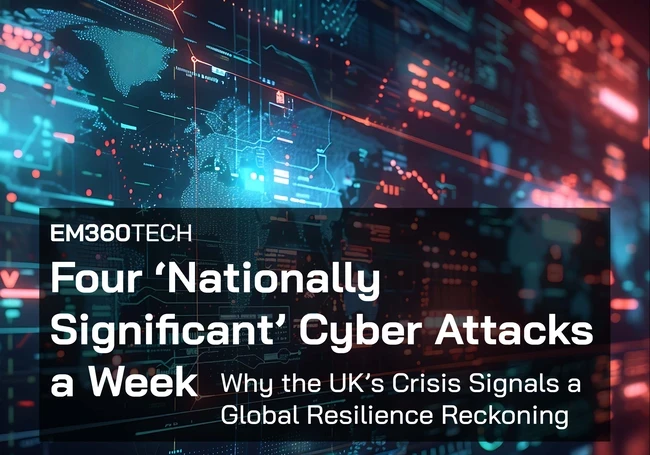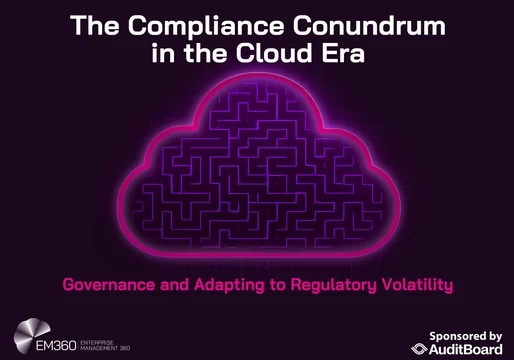The UK’s National Cyber Security Centre (NCSC) has confirmed a sharp escalation in threat activity. In the 12 months to August 2025, the NCSC handled 429 incidents, including 204 “nationally significant” attacks, up from 89 the year prior. Eighteen were classed as “highly significant,” an increase of roughly 50 per cent.
That is an average of four nationally significant attacks every week, with growing severity and complexity that test national resilience and enterprise continuity alike. The signal is clear. This is not a one-off spike or a data quirk. It's a structural warning for any organisation operating in a connected economy.

From National Threat to Global Pattern
The surge documented by the NCSC is not happening in isolation. Similar warning lights are flashing across the world, from North America to Asia-Pacific, as cyber incidents grow in both scale and sophistication.
What began as a national security concern for the UK is now part of a broader pattern showing how digital economies everywhere are being stress-tested at once.
The UK’s rising tide
The cost and reach of disruption are now macroeconomic issues. The Jaguar Land Rover incident forced weeks of production stoppages and triggered a £1.5 billion government loan guarantee to stabilise the supply chain. When critical manufacturers pause, upstream and downstream partners stall, liquidity tightens, and regional employment absorbs the shock.
That is why the NCSC is framing this surge as a resilience challenge rather than a narrow security problem.
A worldwide escalation
The UK is not an outlier. In the United States, the FBI’s 2024 Internet Crime Report recorded $16.6 billion in reported losses across more than 859,000 complaints, a 33 per cent year-on-year rise, with extortion and data theft prominent in the mix.
Across Europe, ENISA’s Threat Landscape tracked 4,875 incidents from July 2024 to June 2025, finding distributed denial-of-service dominant by volume while ransomware remains the most damaging. Australia’s latest cyber threat report underscores the same pattern of frequent ransomware and supply-chain exposures.
Singapore’s national review highlights rising ransomware and a marked jump in infected infrastructure, often tied to unpatched systems. Different regions, same weaknesses, and similar operational consequences.
The Expanding Attack Surface — Where Risk Now Lives
Enterprise boundaries no longer map to traditional IT perimeters. Connected devices and operational technology underpin heating and power, patient monitoring, logistics, production lines, and retail operations.
Wireless Logic’s commentary lands a practical point: thousands or even millions of endpoints now sit outside legacy perimeter models, creating blind spots where attackers can move unseen.
The security task is not just to harden a single device. It is to authenticate, observe, and govern sprawling networks of devices that interact with customers, partners, and critical infrastructure.
Manufacturing, healthcare, utilities, and retail exemplify the shift. Device fleets generate telemetry, automate decisions, and link to third-party ecosystems. Legacy models that rely on static perimeters and periodic audits cannot keep pace with the scale and dynamism of these environments.
Visibility and strong identity have therefore become the strategic control points. If you cannot enumerate and verify what is connected, you cannot defend it. This is where built-in resilience, continuous anomaly detection, and secure-by-design connectivity become table stakes rather than optional sophistication.
Data, Encryption, and the Next Frontier of Resilience
Resilience does not start at the firewall. It starts with how data is protected and managed. Arqit’s perspective is instructive here: organisations must know where their weaknesses lie, especially in cryptographic controls that protect sensitive data while in motion and at rest.
Ageing algorithms, fragmented key management, and opaque crypto inventories create hidden liabilities. The horizon is shifting again as post-quantum cryptography (PQC) moves from theory to deployment.
The NCSC has launched a PQC migration pilot and has approved consultancies to help government and critical industry discover cryptographic dependencies and plan upgrades. Arqit is among the participants selected to support discovery and migration planning.
This matters at board level. Crypto-modernisation is not a compliance tidy-up. It is future-proofing for confidentiality and integrity in the next decade of digitisation. Migration will require inventories of algorithms and keys, hybrid modes during transition, and careful sequencing to avoid service disruption.
Enterprises that treat this as a strategic programme will reduce breach blast radius, lower regulatory exposure, and preserve customer trust as cryptographic standards evolve.
The Ripple Effect — What This Means for Enterprises Everywhere
The policy climate is converging on board accountability and timely transparency. In the United States, the Securities and Exchange Commission’s final rules require public companies to disclose material cybersecurity incidents on Form 8-K, generally within four business days of determining materiality, alongside annual disclosures on risk management and governance.
Japan has passed an Active Cyber Defence law that expands authorities’ powers and mandates stronger coordination and reporting. These initiatives reflect a common logic: cyber risk is enterprise risk, and disclosure, governance, and preparedness must keep pace.
Strategy is evolving accordingly. The objective is no longer to protect everything equally. It’s to assume breach and maintain continuity. That means prioritising the systems that carry safety, revenue, and reputation, then engineering for graceful degradation, rapid detection, and fast recovery.
The organisations that do this well will hold a visible advantage in procurement, insurance, and customer trust. Resilience becomes a competitive differentiator in a world that expects disruption.
Where Industry Action Must Accelerate
Across sectors, the message is converging: resilience cannot remain a policy discussion or a post-incident aspiration. It needs to translate into clear, measurable actions that strengthen enterprise defences before the next disruption strikes. The following priorities define where that acceleration must begin.
As one vivid local case, Wits University in South Africa recently disclosed a zero-day attack against its IT systems, exploiting a vulnerability unknown to Oracle and other software vendors. The university says it has notified the Information Regulator, is collaborating with Oracle and cybersecurity specialists, and continues core operations while investigating what data may have been compromised. enca.com+1 This incident underscores one truth repeatedly emerging across geographies: no organisation, however local or academic, is immune from advanced, unknown threats.
Secure the edge
Build an authoritative inventory of connected endpoints, from sensors and kiosks to clinical devices and shop-floor robots. Enforce strong authentication, segment by criticality, and monitor continuously for drift and anomalous behaviour. Treat vendor and partner devices as part of the same risk surface, not separate domains.
Modernise encryption
Map cryptographic assets across applications and data stores. Replace those ageing algorithms, expedite your crypto-agility implementation, and plan for PQC adoption where it’s appropriate. Also use hybrid modes and tested migration patterns to help avoid unwanted downtime and hidden regressions that slow you down. Finally, align upgrades with data classification so the most sensitive flows move first.
Measure resilience
Set your targets for mean time to detect and mean time to recover, then use red-team scenarios and tabletop tests to stress test and improve them. Share your findings as trendlines in executive scorecards so that improvement is both visible and accountable. Make sure that disclosure playbooks meet regulatory timelines, especially in instances where four-day windows apply for material incidents.
Final Thoughts: Resilience Starts Before the Attack
The UK’s surge in nationally significant attacks is a wake-up call for every connected economy, proof that defences built for yesterday cannot sustain tomorrow’s interdependence. National and enterprise stability now hinge on the intersection of data, devices, and decision-making under pressure.
Lasting security isn’t about reacting faster. It’s about thinking ahead — building resilience into systems, decisions, and leadership before pressure hits. If this moment is prompting a reassessment of where your organisation is most exposed, start with precision: know what’s critical, know how it breaks, and make resilience the measure of readiness.
Explore EM360Tech’s latest updates on edge visibility, crypto-modernisation, and operational resilience to benchmark your programme against peer practice and move from intent to measurable progress.







Comments ( 0 )